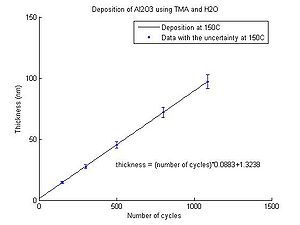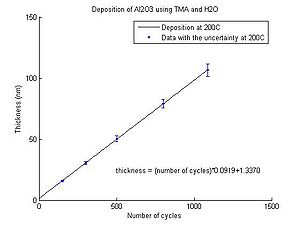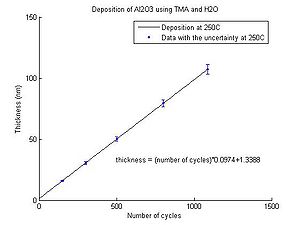Specific Process Knowledge/Thin Film deposition/ALD/Al2O3 deposition using ALD: Difference between revisions
No edit summary |
No edit summary |
||
| Line 2: | Line 2: | ||
=<span style="background:#FF2800">THIS PAGE IS UNDER CONSTRUCTION</span>[[image:Under_construction.png|200px]]= | =<span style="background:#FF2800">THIS PAGE IS UNDER CONSTRUCTION</span>[[image:Under_construction.png|200px]]= | ||
The ALD window for depostion of | The ALD window for depostion of aluminium oxide ranges from 150 <sup>o</sup>C to 350 <sup>o</sup>C. XPS measurements shows that at temperatures below 150 <sup>o</sup>C the Al<sub>2</sub>O<sub>3</sub> will be contaminated by unreacted TMA molecules, and at temperatures above 350 <sup>o</sup>C the TMA decomposes. | ||
The deposition rate for Al<sub>2</sub>O<sub>3</sub> depends on the temperature, see the graph below. | The deposition rate for Al<sub>2</sub>O<sub>3</sub> depends on the temperature, see the graph below. | ||
| Line 14: | Line 14: | ||
In the graphs below the Al<sub>2</sub>O<sub>3</sub> thickness as function of number of cycles for deposition temperatures between 150 <sup>o</sup>C and 350 <sup>o</sup>C can be seen. From the equations the number of cycles required for a certain thickess can be calculated. The results have been obtained using the "AL2O3" recipe: | In the graphs below the Al<sub>2</sub>O<sub>3</sub> thickness as function of number of cycles for deposition temperatures between 150 <sup>o</sup>C and 350 <sup>o</sup>C can be seen. From the equations the number of cycles required for a certain thickess can be calculated. The results have been obtained using the "AL2O3" recipe: | ||
<b>Recipe | |||
<b>Recipe</b>: AL2O3 | |||
<b>Temperature</b>: 150 <sup>o</sup>C - 350 <sup>o</sup>C | <b>Temperature</b>: 150 <sup>o</sup>C - 350 <sup>o</sup>C | ||
| Line 38: | Line 39: | ||
|} | |} | ||
<gallery caption=" | |||
image:ALD Al2O3 grow rate 150C.jpg| | <gallery caption="Aluminium oxide thickness as function of number of cycles" widths="300px" heights="300px" perrow="3"> | ||
image:ALD Al2O3 grow rate 200C.jpg| | image:ALD Al2O3 grow rate 150C.jpg| Temperature 150 <sup>o</sup>C. | ||
image:ALD Al2O3 grow rate 250C.jpg| | image:ALD Al2O3 grow rate 200C.jpg| Temperature 200 <sup>o</sup>C. | ||
image:ALD Al2O3 grow rate | image:ALD Al2O3 grow rate 250C.jpg| Temperature 250 <sup>o</sup>C. | ||
image:ALD Al2O3 grow rate | image:ALD Al2O3 grow rate 200C.jpg| Temperature 300 <sup>o</sup>C. | ||
image:ALD Al2O3 grow rate 250C.jpg| Temperature 350 <sup>o</sup>C. | |||
</gallery> | </gallery> | ||
Evgeniy Shkondin, DTU Danchip, February-March 2014. | Evgeniy Shkondin, DTU Danchip, February-March 2014. | ||
Revision as of 11:21, 27 March 2014
THIS PAGE IS UNDER CONSTRUCTION
The ALD window for depostion of aluminium oxide ranges from 150 oC to 350 oC. XPS measurements shows that at temperatures below 150 oC the Al2O3 will be contaminated by unreacted TMA molecules, and at temperatures above 350 oC the TMA decomposes.
The deposition rate for Al2O3 depends on the temperature, see the graph below.
 |
|---|
In the graphs below the Al2O3 thickness as function of number of cycles for deposition temperatures between 150 oC and 350 oC can be seen. From the equations the number of cycles required for a certain thickess can be calculated. The results have been obtained using the "AL2O3" recipe:
Recipe: AL2O3
Temperature: 150 oC - 350 oC
| TMA | H2O | |
|---|---|---|
| Nitrogen flow | 150 sccm | 200 sccm |
| Pulse time | 0.1 s | 0.1 s |
| Purge time | 3.0 s | 4.0 s |
- Aluminium oxide thickness as function of number of cycles
-
Temperature 150 oC.
-
Temperature 200 oC.
-
Temperature 250 oC.
-
Temperature 300 oC.
-
Temperature 350 oC.
Evgeniy Shkondin, DTU Danchip, February-March 2014.



